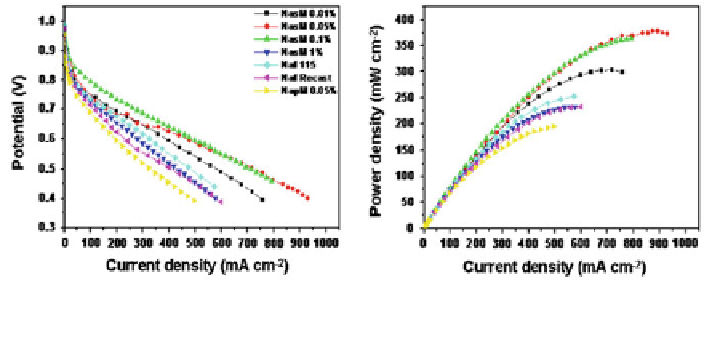Environmental Engineering Reference
In-Depth Information
Fig. 5 Polarization plots of showing the potential and power density variations with increasing
current densities
sulphonic acid moieties through microwave treatment in HNO
3
-H
2
SO
4
mixture
[
91
,
92
]. Interestingly, this sulphonic acid functionalized CNTs (s-CNTs) are more
soluble in water and dimethylacetamide, offering additional advantages of flexi-
bility in terms of membrane processability.
We have prepared several composite membranes based on Nafion-s-CNTs, with
a systematic variation in CNT weight percentage from 0.01 to 1 %, beyond which
there is saturation in proton conductivity. The results show that for both types of
s-CNT-Nafion composite membranes, there is an increase in proton conductivity
coupled with increased mechanical stability of the membrane. The cause for this
enhancement is revealed by the small angle X-ray scattering experiments (SAXS)
where the hydrophilic ionic domain size change shows a strong correlation with
the increase of CNT content and proton conductivity. The domain size measured
from SAXS measurements reveal approximately 50 Å clusters from commercial
Nafion 115 membranes while composites exhibit a saturation limit of about 70 Å
both for 0.05 and 0.1 % of s-CNT content (Table
1
) in the composite.
These results are well supported by the fuel cell polarization experiments where
0.05 and 0.1 % composites have shown increased current and power densities than
that of commercial and recast Nafion membranes of similar nature (Fig.
5
). This
result shed some light on the possibility of s-CNTs to play a vital role in enhancing
the conductivity of composite electrolyte (reduced activation energy for proton
transport) and also on the improved robustness of the membrane, presumably due
to the amount of functionalized CNTs. Our further attempts to vary the -SO
3
H
content by changing the microwave treatment time and related parameters are
compared in Table
1
with available data from other reports. For example, Peng
et al. have prepared sulphonated CNTs by heat treatment with H
2
SO
4
at 250 C
under N
2
atmosphere to attain a sulphonic acid content of 15 wt% which is much
higher than the 2.5 wt% sulphonated CNTs that we used form composite mem-
brane fabrication. However, there is no fuel cell polarization data and the presence
of too much of sulphonic acid groups might create adverse effects in terms of
corrosion and membrane degradation [
44
,
45
].

Search WWH ::

Custom Search